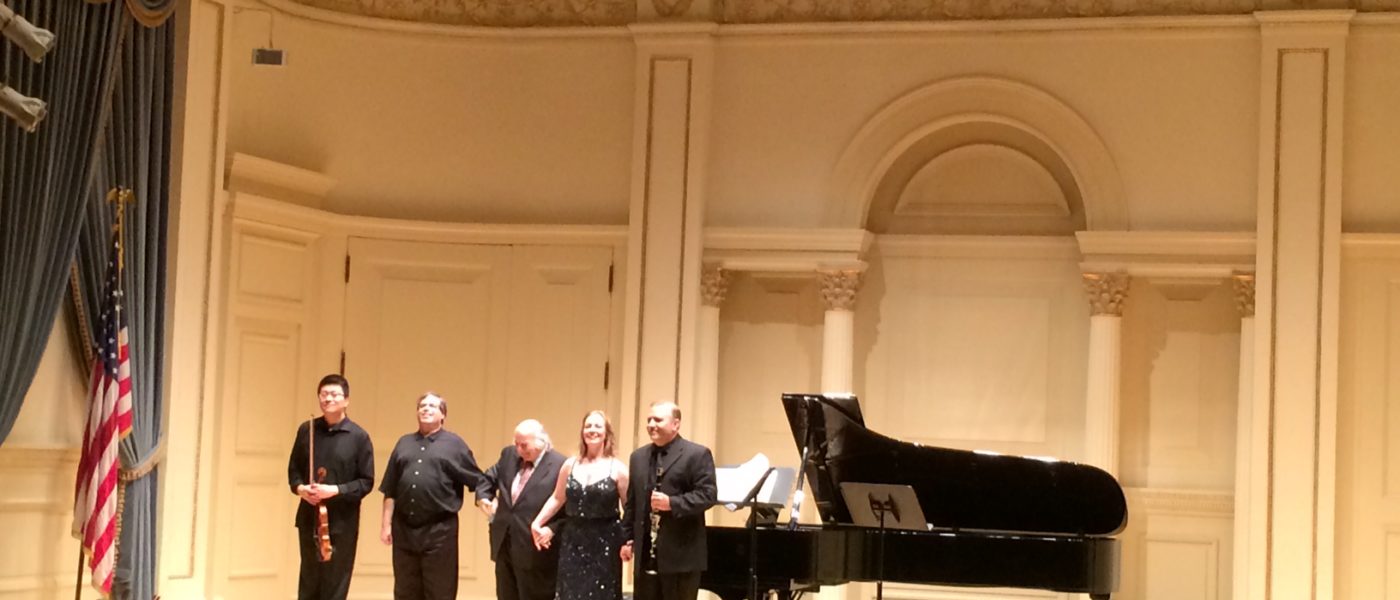Distinguished Concerts International New York (DCINY) presents The Music of Dinos Constantinides in Concert in Review
Distinguished Concerts International New York (DCINY) presents The Music of Dinos Constantinides in Concert
Dinos Constantinides, composer
Maria Asteriadou, Michael Gurt, piano; Kurt Nikkanen, violin; Yung-Chiao Wei, double bass
Hamiruge, The LSU Percussion Group: Brett Dietz, Eric Scherer, Manuel Treviño, Kyle Cherwinski
Weill Hall at Carnegie Hall, New York, NY
October 1, 2017
Distinguished Concerts International New York (DCINY) opened its 2017-2018 season on October 1, 2017 with a concert entitled The Music of Dinos Constantinides. This is the tenth time that DCINY has presented the music of Mr. Constantinides. On hand were eight talented colleagues of Mr. Constantinides from Louisiana State University to present a survey of works from his long career. The performers were pianists Maria Asteriadou and Michael Gurt; violinist Kurt Nikkanen, double-bassist Yung-Chiao Wei, and percussionist members of Hamiruge (LSU’s percussion ensemble), Brett Dietz, Eric Scherer, Manuel Treviño, and Kyle Cherwinski.
Greek-born Dinos Constantinides is the head of Composition and Music Director of the Louisiana Sinfonietta at Louisiana State University. He is presently Boyd Professor, the highest academic rank at LSU. Mr. Constantinides has composed over 300 works, including six symphonies, two operas, and music for a wide variety of instruments and voices, and has a long list of prizes won and excellent reviews worldwide. His writing style is all-encompassing, from the simplest of forms to the ultra-complex, and from the strictly tonal to the acerbically atonal and serial. He is especially adept in his use of Greek influences, such as Greek poetry from both ancient and modern sources, and Greek modal harmony.
This is my third occasion to review Mr. Constantinides’s music, and anyone who read my two previous reviews may recall that I expressed my reservations about the excessive length of the concerts. I will confess that I was fully expecting to do so for a third time, but I have the great pleasure of saying that this was not the case. Perhaps I might be flattering myself in believing that my concerns were heeded, but whatever the case, it was a pleasant surprise.
Violinist Kurt Nikkanen and pianist Maria Asteriadou opened the first half with Patterns for Violin and Piano, LRC 119b, a highly dramatic work that was played with passion by both players. In particular, Mr. Nikkanen’s sound projected boldly, as his robust tone filled the hall without any stridency. It was to be this listener’s favorite selection of the evening. Mr. Nikkanen followed with the Sonata for Solo Violin, No. 3, LRC 63 (Kaleidoscope), a work that can be described as either serialist or experimental in nature. It was amusing to see the poster-sized score being carefully placed on the music stand before Mr. Nikkanen began. This work is thorny for the performer and listener alike, and Mr. Nikkanen’s fine performance might have not gotten the credit it deserved from the audience, but this listener was impressed. It was not just his commitment to this difficult piece, but also his technique in dealing with the challenges that abounded throughout. The Theme and Variations for Solo Piano, LRC 1, played by Ms. Asteriadou followed. The composer writes in his notes that this work is based on a famous Greek folk tune (but does not name the actual tune). The melodic line is definitely modal, but the harmonies have diverse styles, including bi-tonality. One could hear hints of Chopin, Schumann, Liszt, and even Debussy throughout this eight-minute work, which Ms. Asteriadou played with an evident reverence.
To end the first half, Mr. Nikkanen and Ms. Asteriadou offered the twelve-tone Sonata for Violin and Piano, LRC 21c. It would seem that Mr. Nikkanen has a special affinity for taking on works that require a huge technique without any real hope of the general listening public to be wowed by that technique (read: This work is not Sarasate). Kudos to both Mr. Nikkanen and Ms. Asteriadou for their excellent playing.
After intermission, double bassist Yung-Chiao Wei and pianist Michael Gurt offered Reverie II for Double Bass and Piano, LRC 81b, a lovely three-minute work. Mr. Gurt followed with a sensitively played Two Preludes for Piano, LRC 101b, the first of which employs melodic lines from the First Delphic Hymn (c. 138 B.C.(!)) according to the composer. I’m not at all sure about this, but I’m going to give Mr. Constantinides the benefit of the doubt! Ms. Wei and Mr. Gurt returned for the Concerto for Double Bass and Piano, LRC 269b, derived from a cello concerto. It showcased Ms. Wei’s virtuosity to say the least. It was notable how well she articulated some rapid passagework that one would have not expected to be possible on the double bass. Other than a few moments when there were some balance issues, it was a remarkable performance. Percussion Quartet No. 2, LRC 270, featuring Hamiruge, The LSU Percussion Group, closed the evening. This four-movement, fifteen-minute work saw the members of Hamiruge playing xylophones, wood blocks, suspended cymbals, snare drum, timpani, chimes, triangles, and even the celesta. It was mesmerizing both to see and to hear. The audience responded with prolonged applause. Mr. Constantinides was present and came to the stage to join all performers to accept the continued applause of the large audience.

